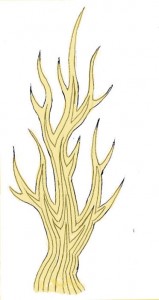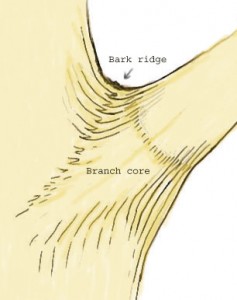The anatomy of pruning covers many areas. If you are like me, it’s not enough to just know how to prune correctly – I need to know why this pruning is correct.
This article addresses the “why’s” of proper tree pruning in three main points: Where to make the cut, when to make the cut, and why it’s important not to cut too much.
Why do I cut at the branch collar?
In each successive year, a tree divides and expands its cells gaining length at the shoot and root tips. With this cellular gain, the entire tree expands along its circumference.
In the simplified picture below (1) you see there is a layering of conical-structures stacked one inside another. This layering of cones becomes interesting at the branch-to-trunk union, as they grow successively one over the other (as if woven together).
It is this weaving that creates the branch collar. Inside the branch collar is a decay-resistant inverted cone that is called the branch core. This is why it is well advised to cut to, but not into the branch collar.
Cutting into the branch collar opens up the wood of the trunk (or parent stem) to decay, and negates the protective barriers that the tree has established.


This is also why a crown reduction should be done very sparingly, as the cuts that are made are called drop-crotch cuts. This cut removes the parent stem just above a branch, and leaves no branch collar and no branch core… therefore no protective barrier.
When to make the cut
One of the most common questions I am asked is what time of year should I prune my trees. I usually tell a client that pruning anytime during the year is possible – as we adjust our pruning techniques for each season. Though with most careful pruning procedures, there are always exceptions.
When should you prune?
The best time to prune a tree is late in the dormant season (late winter). They are expending very little energy and have very little time for infectious diseases to move into the pruning wounds before the tree can begin growing over the cut.
The second best time to prune is mid-to-late summer, before the leaves start to turn. This is a good time to prune because the tree is no longer growing and has not started to withdraw the energy from the leaves to store it for spring.
The third option for pruning would be in autumn. Pruning in the autumn months interrupts or removes the available energy that would otherwise be put away for the spring flush. During this time, pruning must be done to a lighter degree.
In spring and during flowering periods of any season, the tree is expending a great deal of energy toward cell expansion while receiving very little energy from photosynthesis. During this time, the tree is giving growth it’s all and has little energy to divert towards defense.
It is still okay to prune during this time of year (when tree is too busy to be bothered), but the amount of living branches removed needs to be adjusted to account for the trees physical requirements.
Removing deadwood
Removing deadwood is a good thing to do at anytime of the year. It does not interrupt any of the trees natural processes and ensures energy is being used in the most efficient manner.
Deadwood removal on a tree also minimizes potential damage. It allows the branches being removed to be cut clean to the branch collar (as opposed to breaking-out during wind or other environmental effects).
Don’t prune too much
It is important not to over-prune at any time during the year. Over pruning disrupts the balance of two phytohormones: Auxin (produced in the shoots) and Cytokinin (produced in the roots).
When the supply of Auxin is reduced to a level that is too low by over pruning, there is an abundance of Cytokinin. Cytokinin is the hormone that is in part responsible for shoot development.
This is the cause of unhealthy and ugly sucker growth (or “water sprouts”) due to over pruning. In a sense, it is similar to humans with chemical imbalances… the trees go a little crazy.

